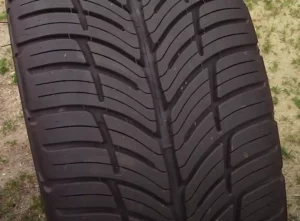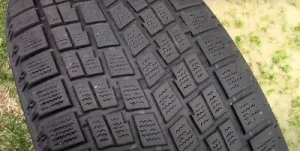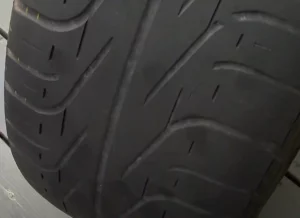Last updated on April 5th, 2024 at 11:05 am
Rubber, unlike plastic or metal, changes its form due to the elasticity and flexibility it possesses. As the external area of the tire is purely made with rubber, it also changes its form after a few years of drive.
The most important part of the tire is its tread; as the car moves, the tire tread makes contact with the road to achieve all the features that modern drivers want from their tires, comfort, traction, and many other things.
In the start, when the tire is new, the tread levels are all sharp and balanced, however, as time goes on, slowly, sometimes quickly, the tire tread starts wearing off due to the drag it consumes from the pavements.
As the tread levels drop, the performance of the tire drops with it too. There is nothing you can do to prevent this from happening; every tire, at some point, will lose its tread, and you have to replace them, That is the game.
So which tread level is too low, is the same for all tires, and when should you replace your tires? All that and many more will be answered in this article, so keep reading till to end to find out all and travel more efficiently and safely with proper tread levels.
Table of Contents
Minimum Tread Level
10/32 tire tread

Usually, all-season and all-terrain tires come at this tread level, somewhere between 12-10/32. It is the perfect tread level to drive your car, the tire has all the ability to deliver the performance it was designed to deliver. The immature wear won’t be an issue, and the abnormal punctures and flats won’t be an issue as well.
The tire will be at its peak of performance. There is no need to replace tires at this tread level; if they look old, just use tire shine, and you won’t be able to differentiate between brand new and your tires.
6/32 tire tread

Usually, sports car tracks and high-performance tires come at this tread level. Even though it is not the ideal tread, it won’t be so bad to make a drive unsafe. The tire might lose a little bit of performance however, if the tire is of good brand, it will keep performing as well as it did at the start.
As the demand for track is slick tires, that is why performance tires are made with this tread level, otherwise, if you are buying new tires for everyday road, it won’t be a good tread level for new tires. Always go with a tread level above 9/32 if you want durability in your tires.
2/32 tire tread

This is the tread level where no new tires will be acceptable. Instead, this is where you should replace your tires, as this is not the proper level to handle the situation. The 2/32 is the tread level which is not safe to drive on roads, due to the contact it made with the road.
The car will lose balance, no traction will be there, and many other chances of blowout and stuff. That is why as you reach around 3/32, start searching for tires, and replace them; if not, then after 2/32 tread level, there is no way it is a sensible choice to drive with worn tires.
Causes Of Low Tread Level
Safety Issues
The safety of the drivers on the road is the most important thing, above anything else. As the tire wears off at the level of 2/32, your journey could become dangerous. The contact with worn tread can bring so many bad possibilities, including, a sudden blowout at speed, imbalance, and fail contact.
That is why rather than sucking all life out of the tire, always choose a safer option and replace your tires before the minimum tread level. In this way, you will achieve safer rides, and protect yourself, others, and your vehicle from any damage.
Vibration and Instability
Another thing that could be a sign of low tread level is constant vibration on slow driving. This could also be a sign of immature or uneven wear-off among other tires. So make sure you find out the problematic tire and replace it before it causes any trouble.
Wheel damages
Low-tread tires can also damage the wheel, as the distance between the road and the wheel reduces due to dragged-off tires. As the force is put on the wheel, damage can occur on the axle and even on the suspension of your car. So don’t take this thing so easy and replace the tires as soon as possible after the 3/32 tread level.
How To Check Tire Tread
Penny check
It is an efficient way of checking the tread levels of the tire. Just pick straight from the bottom and put the head of Lincoln between the tread grooves of the tire. If no part of the head or a little bit of the head is visible, it means the tread levels are perfect, which is 10/32 of tread depth.
If you can see the lips and nose of the Lincoln, it means the tread levels are adequate, which would be 6/32 depth. However, if you see the whole face, then it is the right time to replace the tire, and your tire will be below 3/32 of tread depth.
Tread check tool
There are hundreds of tools that you can buy from any retail shop; they are easy to use, cheap, and show accurate tread levels in millimeters and in fractions. So buy anyone you like and keep it in your car to regularly check tires and catch if any tire is wearing off immaturely.
Tire indicators
Some tires have written values and numbers that inform drivers about certain conditions. For example, one of the continental all-terrain tires comes with an alphabet which erased after some time as the tire loses tread. When the tire goes below 6/32, the S erases, which indicates the tire is not suitable for winter and snow terrain. Similarly, when all alphabets vanish, that’s when the tire needs replacement.
How To Avoid Early Wearoff
Rotation
Tire rotation is the most important care tip that every driver should perform. The reason for doing tire rotations is to balance the force and torque between each tire. Usually, vehicles are rear or front-wheel drive, so the tires installed on the front or rear axle, depending on the car, have to handle more force and drag more compared to other axle tires.
So rotating tires make them wear off evenly, which reduces the chances of immature wear. This way, the car and tire performance remains stable and tire durability as well.
Maintenance
With rotation, after 6 months or so, also do some maintenance of your tire, check the air pressure, alignment, balance, and other things. Sometimes applying tire shines and cleaning properly will also do some good in the long run. With proper wear, you will also catch if some tire is having an issue, which can save you from big trouble as well.
Driving in specific situations
Driving tires in their specific conditions should be the case. Otherwise, they will wear off earlier than you expect. For example, driving summer tires on snow will lead to uneven and early wear off; similarly, driving all-season tires in the most aggressive and deep snow will also lead to early wear.
Not only the tire will not be in use after some time, but the company also won’t even rebate the warranty, as it is written with tires, if it is driven in non-specified conditions, the warranty contract will be voided. So make sure to drive tires in specified conditions, especially if they are.
Conclusion
Low tire tread levels are never to be taken in easily, as they can cause some big troubles on the road for you and other drivers. That is why it is recommended to replace the tires, as they are close to reaching the minimum tread level which is 3/32.
Replacing tires earlier will not only save you from big troubles, but it will also improve the vehicle performance, avoid getting damaged, and many other things. So make sure to check your tire tread properly and buy new tires as the tread goes below the recommended level.
